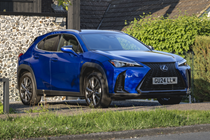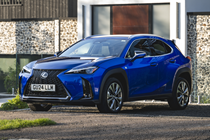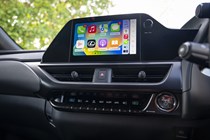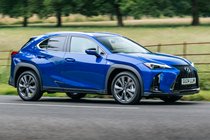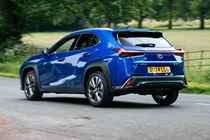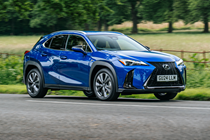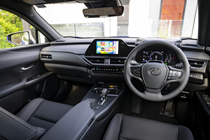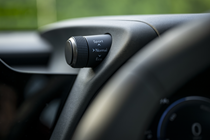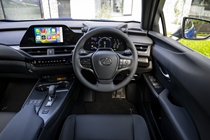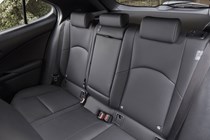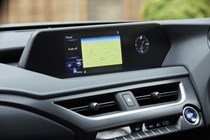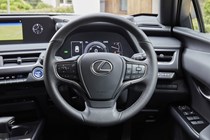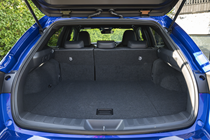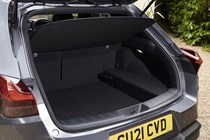
Lexus UX long-term test
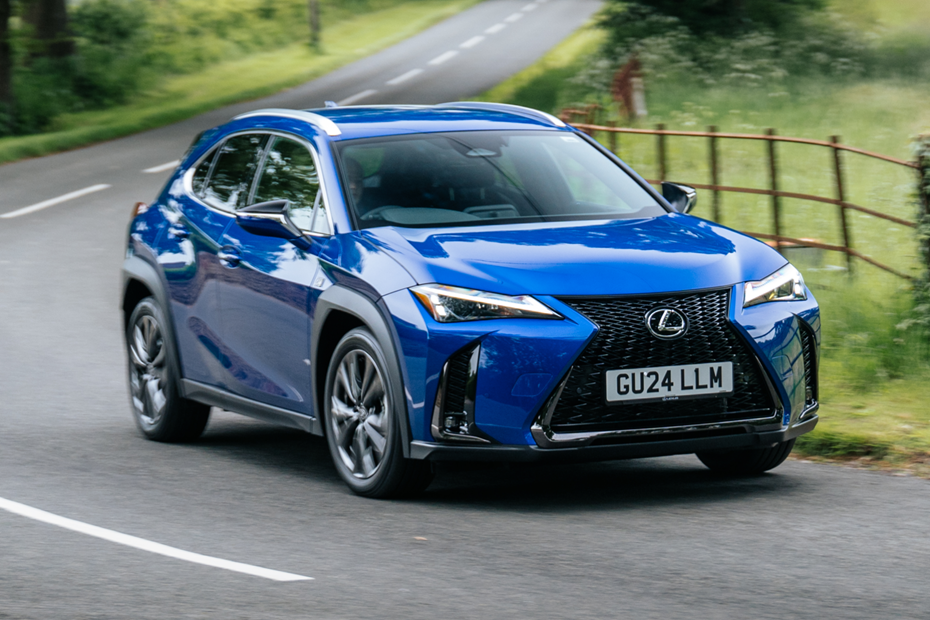
We ran a Lexus UX 250h for six months, between December 2019 and June 2020. Click the links below to jump to individual monthly reports…
- Update 1: Welcome
- Update 2: Driving and performance
- Update 3: We take our UX for a service
- Update 4: Practicality
- Update 5: Interior and tech
- Update 6: Farewell
Update 1: Welcome
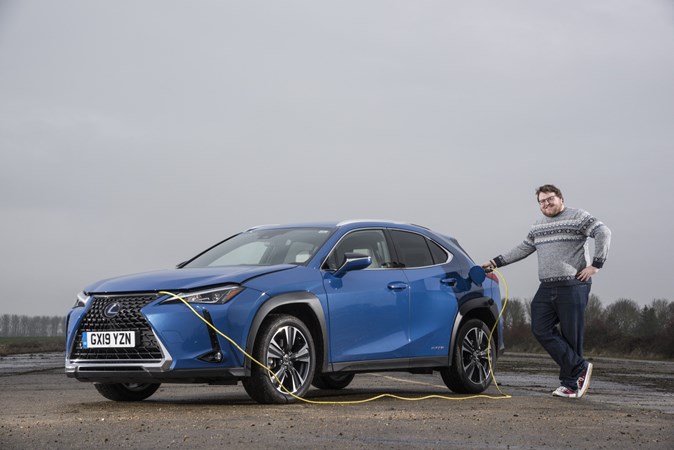
Most car manufacturers are jabbering on about electrifying their model line-ups, some with more ambition than others. But all the while, Lexus has been leading the charge (boo) – offering a hybrid powertrain in every single one of its UK models since 2013.
So while Lexus, or rather its parent company Toyota Group, wasn’t the first to the hybrid game, it’s been the most successful, selling more hybrids than anybody else so far. Yet it’s also proved resistant to change, having yet to launch a plug-in hybrid or pure-electric vehicle and continuing on with what it calls its ‘self-charging hybrid’ powertrain.
To see if it’s still fit for purpose, I’ll be running this for the next six months – a Lexus UX. It’s the smallest SUV in the brand’s four-strong range, and rivals cars such as the Audi Q2, BMW X1 or Volvo XC40.
Self-charging hybrid?
I wanted to tackle this term right away, as it can instil rage into even the most mild-mannered of car enthusiasts online. Type it into Twitter and you’ll find page upon page of not-so-reasoned debate.
Critics say that the term is misleading – it suggests that the car is pulling electricity out of thin air, that it will never need to be refuelled and that all it is is a more efficient petrol car. Toyota says that it addresses buyer’s concerns about hybrid cars – namely, the misconception that you can’t buy one unless you have somewhere to plug it in – and it wants to show that its vehicles do not need external power to perform at their best.
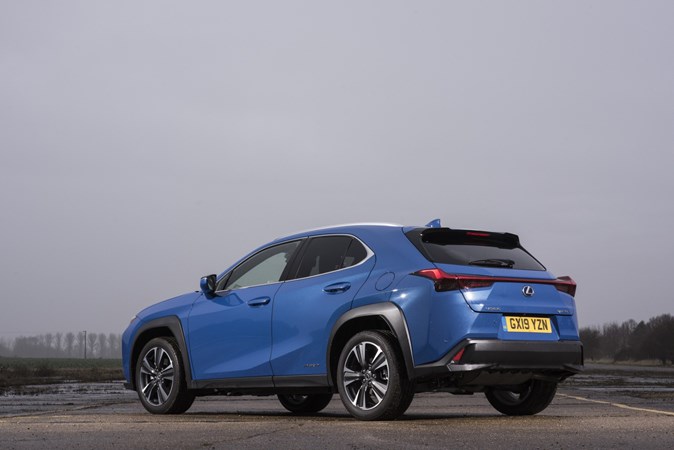
While I can see where the critics are coming from, I don’t really buy that the average consumer is so thick as to believe the car entirely fuels itself. And though I’m not mad on the term, I can’t really think of a better one that extols the virtues of the powertrain while also communicating that it’s different to a plug-in hybrid.
In addition, I think it’s a fairly accurate description. While admittedly all of the power comes from petrol in one way or another, the car charges its battery entirely autonomously – either from the engine or through regenerative braking and coasting.
So there. I’ll be calling this UX a self-charging hybrid throughout these reports. Ner ner ner.
So what’s it actually like?
Superficial things out of the way first – the UX’s design is an acquired taste, but I love the combination of Celestial Blue metallic paint and cream leather that our car rocks. It certainly stands out, with bodywork covered in violent cuts and creases, the aggressive ‘spindle’ grille and a full-width element at the rear providing plenty of interest.
This is a base-spec UX, but it’s fitted with two really important upgrades – the Premium Plus Pack and the Tech and Sound pack. These are pricey options, weighing in at £4,200 and £1,900 – though you can’t have the latter without the former.
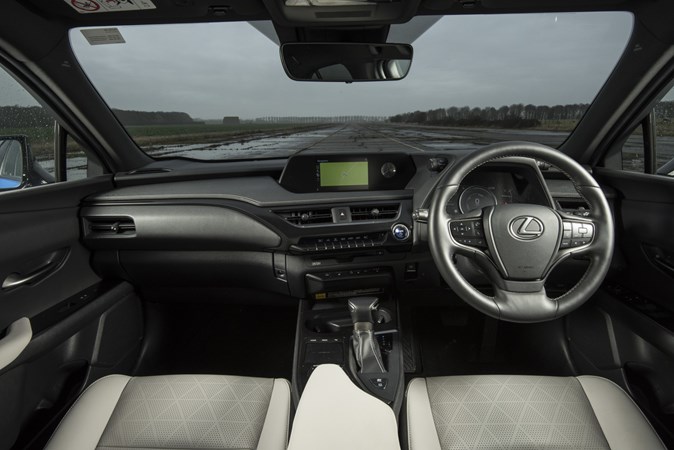
They add plenty of luxury kit, though, which I reckon is fairly essential on a premium-badged model such as this. In fact, for the £6,100 total you get 25 new features – not a bad ratio. They include keyless entry, all-round parking sensors, heated and electrically adjustable front seats, 18-inch alloy wheels and privacy glass, which are all useful touches.
Naturally, as a bit of a tech geek, I’m more interested in the wireless charging pad, digital dashboard, head-up display and 13-speaker Mark Levinson stereo system. I can confirm that it sounds absolutely mega.
I’ll admit to being slightly less enthusiastic over the prospect of six months with Lexus’ infotainment system. More on that in a future update, but for now, all you need to know is that it took three fairly experienced automotive journalists around 10 minutes to figure out how to turn the sat-nav’s voice commands off.
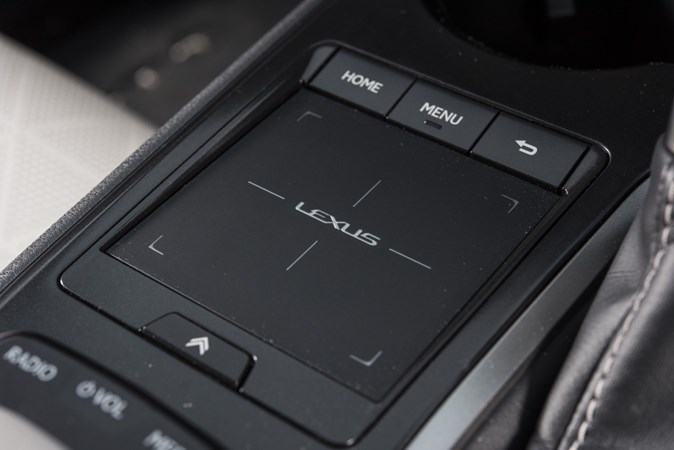
Our UX also lacks Apple CarPlay and Android Auto, though there’s great news on that front – 2020 model year cars come with the software installed, and it’s an upgrade that will be applied to our car at its next service. Toyota Group has dragged its heels on this smartphone integration for years, and it’s fantastic to finally see it become available.
Speaking of service, Lexus has supplied us with a car with a few thousand miles on to begin with – it’ll require a trip to the dealers during our term with it. This is great, because it means I’ll get to experience Lexus’ legendary service department first-hand and see if it really does live up to expectations.
Any other disappointments?
I’m a bit miffed that this base-spec model still uses halogen bulbs for indicators – they rather spoil the futuristic aesthetic Lexus is going for with the styling, and I think it’s stingy given this car’s near-£30,000 starting price.
Practicality has already proven an issue. The boot is unbelievably shallow, to the point where even a standard-sized bag of shopping pushes into the parcel shelf. The official figures list the boot space as more than 300 litres, which I take with a grain of salt – there’s certainly less usable space in there than in most superminis or even city cars. It’s not a patch on the likes of the Volvo XC40.
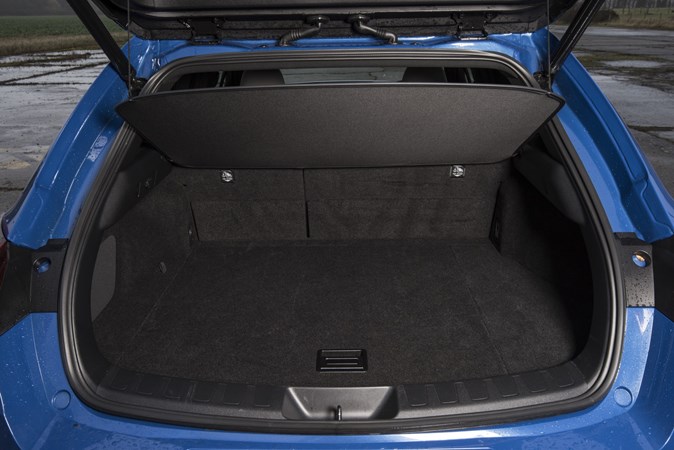
The powertrain is often a sticking point with Lexus hybrids – some love its relaxed nature, others find the sometimes unpredictable nature of the transmission a bore. I’m beginning to lean more towards enjoying it, but there are still times when I yearn for the more enjoyable performance you’d get from a similarly powerful turbocharged petrol engine.
First impressions
I’ve gone through just shy of 1,000 miles over my first month with the UX – a mixture of short runs to and from work and longer cross-country trips. It’s given me plenty of food for thought, but overall it’s proven a surprisingly likable car so far.
But watch this space for greater detail, as there’s plenty more to dive into during our six-month term.
Fuel economy: 47.9mpg
Update 2: Performance and handling
Lexus is a brand known for comfort, stunning build quality and impeccable customer service. That’s not to say all of its models are sedate hybrids, though – cars such as the LC, RC F and even the LFA prove that Toyota’s luxury arm can do ‘exciting’ when it puts its mind to it.
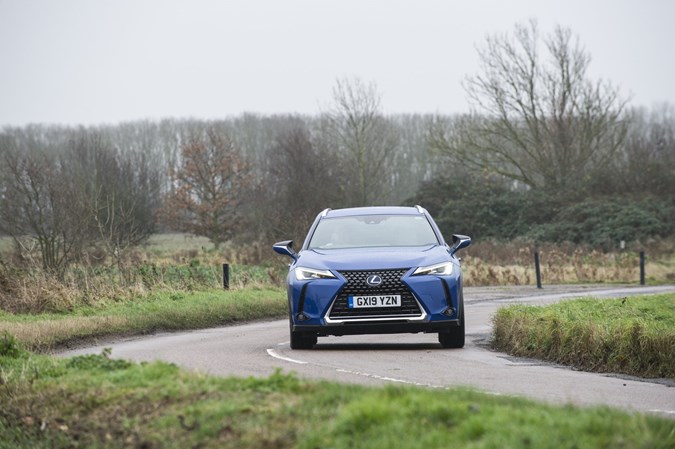
So, did any of that expertise get called up when Lexus put together the UX? After all, small SUVs – especially fashion-led ones like this UX – are bought by young, vibrant types… in theory. Certainly from my perspective, as a single 26-year old (albeit somewhat lacking in vibrancy), I’d like a car that’s good fun to drive. And happily, I can report that, within its own confines – being a hybrid, automatic SUV – the UX is pretty good.
How good can a self-charging hybrid SUV with a CVT actually be?
It’s all about driving within the car’s limits. Put your foot down all the way and you’re in for a rough time. The continuously variable transmission sends the revs spiking as the engine desperately spins up to try and conjure some forward momentum. You could even flick the car into Sport mode and take control of some artificially created gear ratios. But once again, this is a practice full of sound and fury, signifying nothing.
Instead, I’ve found the ideal level of throttle input. Place your foot at about 70% and the electric motor and petrol engine work in sync to bring progress that’s genuinely rapid, yet refined. It’s rather like riding the wave of torque that you get with a diesel, but without the associated tractor-like thrum.
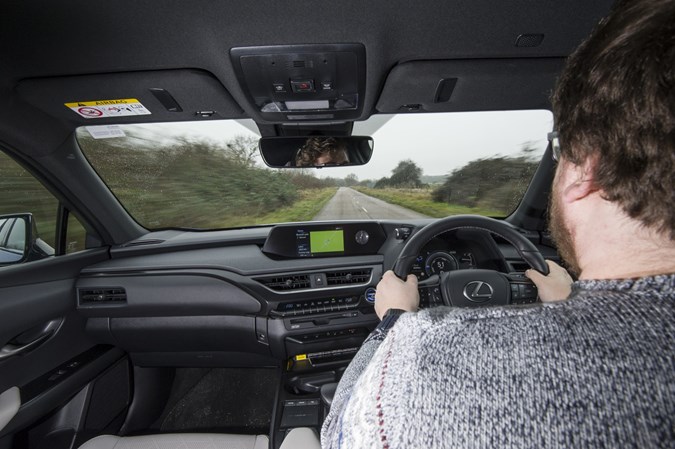
In fact, it’s rather easy to trivialise the fact that the UX really is quite a quick little thing. At full chat, 0-62mph comes about in just 8.5 seconds – the same as an Audi Q2 35 TFSI. Not too long ago, that would have been considered hot hatchback pace.
Hybrid handler
The UX certainly doesn’t handle like a hot hatchback, but that doesn’t mean it’s not good fun. It’s remarkably poised in the corners, and you can carry a fair degree of speed without the car feeling as though it’s on the edge of disaster.
The rear end in particular feels surprisingly communicative – a surprise, for a small SUV. As ever, the steering’s remote and over-light, but that’s par for the course among this car’s competitors.
Relaxed manners make cruising a pleasure
Yet the UX doesn’t encourage spirited driving, and so my average pace has steadily dropped back. I still keep up with traffic, but this car benefits more and more the smoother your inputs become. Drive it carefully and you’ll see the little ‘EV’ symbol light up on the dashboard, signifying that the petrol engine’s been switched off and, for this limited period, you’re not using any fuel at all.
In fact it’s immensely satisfying to see how often, and how long I can get the EV light to stay on for. There’s a knack to it – you need to lift off the accelerator just enough, as if you were encouraging an automatic car to shift into a higher gear. The last mile or so of my commute is a straight 30mph cruise through my village, and I’m now capable of doing this reliably on electric power alone. So it’s disappointing that, despite all this battery-powered motion, I’ve yet to crack 46mpg since the impressive first month…
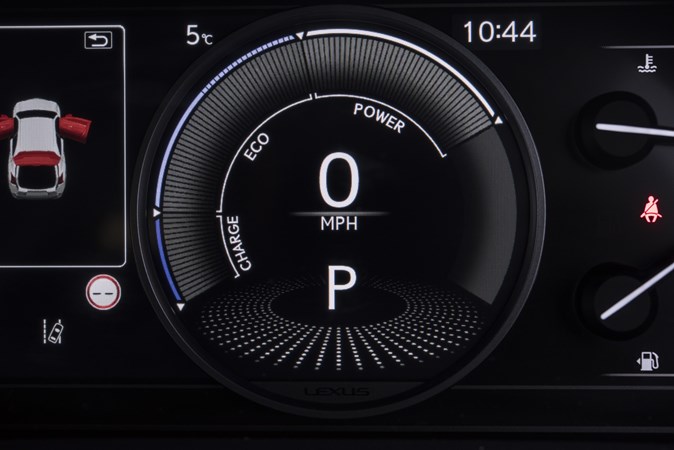
Surprisingly for a hybrid – and I say ‘surprisingly’ because these powertrains are usually at their best around town – the UX is a pleasure to drive on the motorway. The engine has more than enough poke for overtaking at faster speeds, wind, road and engine noise are all well-contained, and the supple ride glides over all but particularly rough surfaces.
The adaptive cruise control and lane-keep assist functions aren’t quite as slick as they were on my previous long-termer, a Honda Civic, though. The cruise control is particularly easily perturbed – even with the following distance at its closest setting, it panics and slows the car down long before I get anywhere near the car in front. The lane-keeping aid, meanwhile, tends to spend all its time twitching the wheel, which is very tiring. I’ve had these both switched off for a while in favour of driving ‘analogue’.
Fuel economy: 45.8mpg
Update 3: A mid-pandemic service for our Lexus UX
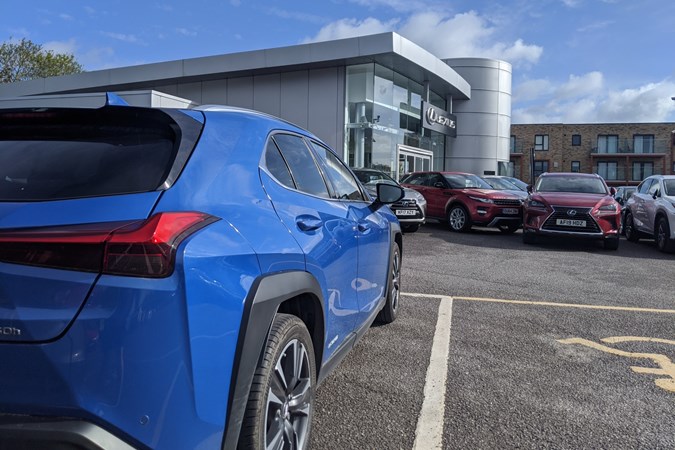
In line with COVID-19 lockdown regulations (and acknowledging that my job here at Parkers, while important, doesn’t make me a key worker) I’ve been hiding out in my spare bedroom for the last six weeks, working from home and allowing my long-term Lexus UX to gather dust outside but for a weekly trip to the supermarket.
Lockdown couldn’t have come at a worse time either, at least where the car is concerned. It was due its first service, at 10,000 miles or one year old – and I’d just booked it in for March 25 when the country locked down, on March 23. Bugger.
>> COVID-19 – tips for drivers
Of course, a short delay on a service interval is hardly a big deal. This is pre-emptive maintenance rather than a particular necessity, and it’s a very badly built car that will go bang if it misses a single scheduled service. The vast majority of car manufacturers have in fact extended their service intervals for the duration of the lockdown period, promising that drivers don’t need to worry about voiding their warranty for missing a scheduled service.
This act has the additional benefit of freeing up space in service bays for key workers – those still working who may need to drive, and for whom a well-maintained car is particularly important.
Some free slots for service still available
Still, I can only assume that the technicians at the Lexus dealer were twiddling their thumbs, because they called me offering a service slot, should I want it. They stressed that I didn’t have to take it, though. Toyota’s official stance is it will take a ‘sympathetic and flexible’ approach to servicing during the pandemic – and if I had concerns, I could delay the service.
I accepted, however, for a few reasons. First, and very selfishly, I desperately wanted to get out of the house – having been cooped up alone for almost two months, the deep but one-sided conversations with my dishwasher were beginning to wear rather thin. Second, I was very encouraged by how seriously Lexus was taking cleanliness and social distancing protocols.

And finally, I intended to sign up to the next wave of NHS volunteers, having already used the car to deliver a few lots of groceries around town – and didn’t want the excess mileage to be a problem.
It’s strange how unnatural driving feels, when you’re back at the wheel for the first time in a while. The trip to my ‘local’ dealer in Cambridge (I live 40 miles away, but my nearby Toyota dealer won’t touch Lexus) took a good hour, and felt deeply weird until I got my head wrapped back around the sensation of speed. It was as uneventful as you’d expect, the UX proving as comfortable and refined as ever.
Social distancing like a pro
Lexus was operating service slots in 15-minute intervals to prevent customers from coming in contact with each other. There’s zero contact with the staff, either – I was invited to sanitise my hands and my car key before placing the latter into an envelope and leaving it on the table. I then collected another envelope with the keys to my courtesy car: another UX, freshly sanitised. Returning was the reverse of this.
The process was quick and reassuring, and though there’s no way to totally mitigate the risks of this virus the procedures in place certainly go a long way to minimising it.
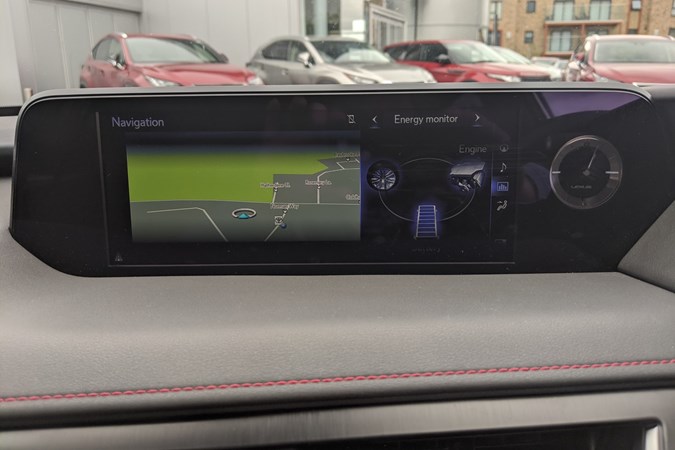
As expected, no warnings were thrown up from the service. All went ahead as planned, with the exception of one thing – I’d been assured an update for the infotainment system would be available, adding Apple CarPlay and Android Auto to the UX’s central screen, but this didn’t materialise. It’s a shame, as the drive reminded me how sub-par Lexus’ system is. Even my courtesy car, fitted with an upgraded setup and a larger, higher-resolution display ran the same awkward system, making it no easier to use.
However, as a first-time recipient of Lexus’ legendary customer service, I was left very impressed. Hopefully the next time we meet won’t be under pandemic conditions…
Fuel economy: 43.5mpg
Update 4: Practicality

One of the key factors that appeals to buyers when opting for an SUV is the promise of space – lots of room in the back seats and in the boot, especially compared with an equivalent hatchback. That’s why in many cases they’ve replaced MPVs in manufacturer line-ups.
Lexus has never sold an MPV in the UK, though, and while many of the brand’s larger cars are immensely practical it’s not a particular brand hallmark in the way it is with, say, Honda or Skoda. Despite this, the UX still falls some way short of the practicality I’d hope to find on a car such as this.
Cramped in the back
Front seat passengers are treated very well, but space in the back is a little more limited. There’s sufficient knee and head-room for adults, but four six-footers will definitely feel cramped. That’s a complaint we can make about the majority of compact SUVs, though.
What makes the UX especially bad, however, is the uncomfortable centre perch, and the high window line and aggressively tinted rear glass that make it very dark and cave-like in the back, despite our car’s light leather.
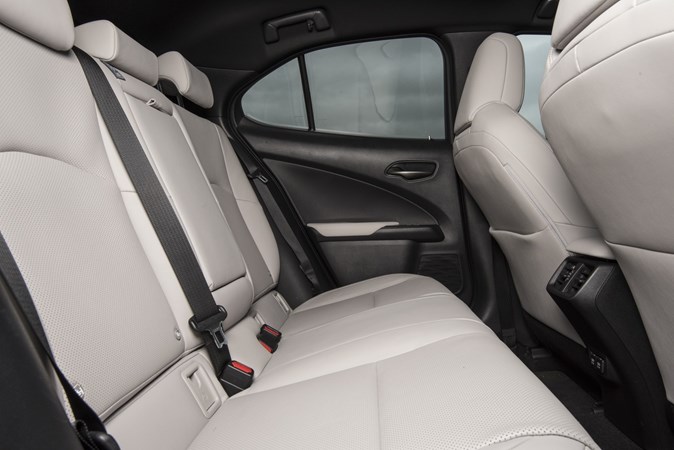
Passengers have also made a curious complaint – that the subwoofer for my car’s (wonderful) Mark Levinson sound system reverberates through the seat, buzzing against their backs and making even short journeys incredibly irritating. I can’t say it’s an issue I’ve experienced myself, even on the few journeys I’ve spent as a rear-seat passenger – but it might be something to consider if you’re buying this car with the intention of regularly transporting people in the rear.
Any issues with the rear seat pale in comparison to those with the boot, though.
Boot? What boot?
The UX’s boot is laughably shallow, to the point it would probably stop me – even with my limited demands on a car’s boot – from buying one. Overall boot capacity is just 320 litres – smaller than a lot of superminis, and much smaller than the 470 litres of a BMW X2 or 405 litres of an Audi Q2.
It’s a long, wide and flat space, but there’s so little space underneath the parcel shelf that even a small bag of shopping ends up squashed.
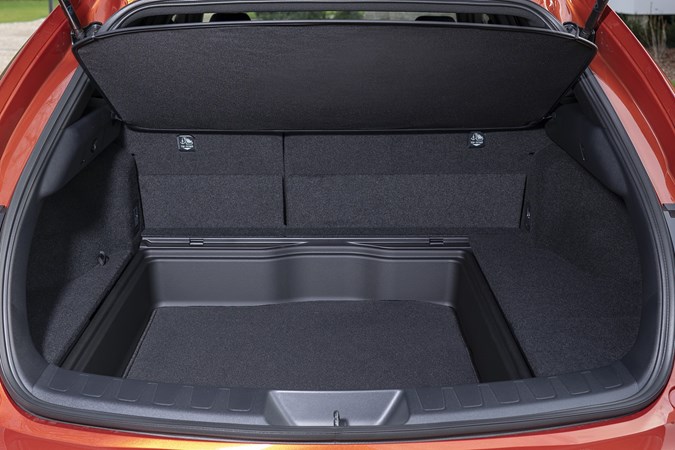
That must be why Lexus opted to fit a flexible, fabric parcel shelf, rather than a rigid one. This conforms itself to whatever’s placed under it, though, leaving a rather unsightly bulge in the rear-view mirror…
The big problem is that Lexus was forced to fit the car’s standard 12V battery back here. It sits just behind the rear wheelarch, and artificially raises the boot floor to this insane level. As a side benefit, you do get a reasonably-sized hidden area underneath the boot floor, but I’d trade that in for more overall height.
At least the seats fold easily and lay almost completely flat, so it’s not as awful at the trademark IKEA run as it could be.
Is it really a problem?
Limited rear-seat room can be disregarded for a lot of small premium cars like this, as they’re often bought by single people or couples who value style over space. The boot, however, is ridiculous – even a supermini can accommodate a weekly shop for two without needing the parcel shelf to be removed.
It’s certainly a feature I’d recommend looking very carefully at before opting to purchase the UX.
Fuel economy: 45.1mpg
Update 5: interior & technology
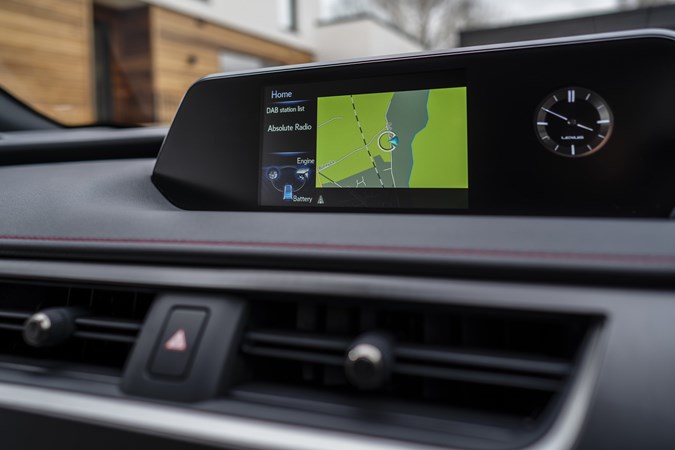
I have a pretty extensive mental list of things in a car’s interior that I enjoy, and things that annoy. Like one of those couples on Escape to the Country who demand six acres and a large characterful kitchen-diner, I’m looking for a few specific items – but can be easily put off by an avocado bathroom suite.
The first is the seats. I like long seat bases to support my long legs, plenty of back support – but not too huggy around the thighs. Tick, tick, and a big Lexussy tick here – the UX, like most Lexuses, has fantastic seats. They’re superbly comfortable and very supportive.
Dials and gauges can make or break a car’s interior. After all, nobody wants information overload, but at the same time it’s tiring to be forced to scroll through multiple sub-menus just to see your remaining fuel, for example. Here’s another area the Lexus does well – its dynamic, part-digital dials show plenty of information, with a small panel off to the side which holds driving data. It’s easy to navigate and attractive to look at. Top work.

You’d hope for excellent build quality with Lexus, and I’m happy to report that even on the little UX everything feels well screwed together with no squeaks, rattles or buzzes at speed.
I’m not one to get dewy-eyed over soft-touch plastics, but the Lexus uses them where it makes sense – with all the places you touch being cushioned and pliable, while surfaces lower down the dash are less so.
Tech all works well
My UX is a base model, but one that’s fitted with the Premium Plus Tech and Sound pack. This brings loads of stuff I reckon is essential if the UX is to compete with cars like the Mercedes-Benz GLA or Audi Q2. Electric adjustment and heating for the front seats, keyless entry, all-round parking sensors should, I think, be standard equipment anyway – while the leather upholstery, high-powered Mark Levinson stereo, head-up display and wireless charging are all nice extras.
The stereo in particular sounds excellent, with deep bass, great clarity and more volume than is strictly necessary. It’s a shame that the infotainment system it’s attached to is so rubbish, though – playing music through Bluetooth feels mighty old-fashioned when competitors allow you to connect Android Auto and scroll through to your heart’s content.
Anything you’re missing?
Well, the 7-inch infotainment screen looks a little bit lost in its surround. Higher-end UX models have a 10.3-inch screen, which means the housing has to be able to accommodate that larger unit. As a result, my car has some rather ugly bezels either side and with the text-heavy interface it can be confusing to navigate.
A 360-degree camera would be nice, but the standard rear-view unit works just fine – no need to upgrade as far as I’m concerned. What I do miss is the more sophisticated LED headlights with adaptive high beam – they might illuminate the road slightly more impressively than my car’s basic LED units, which have a very sharp cut-off.
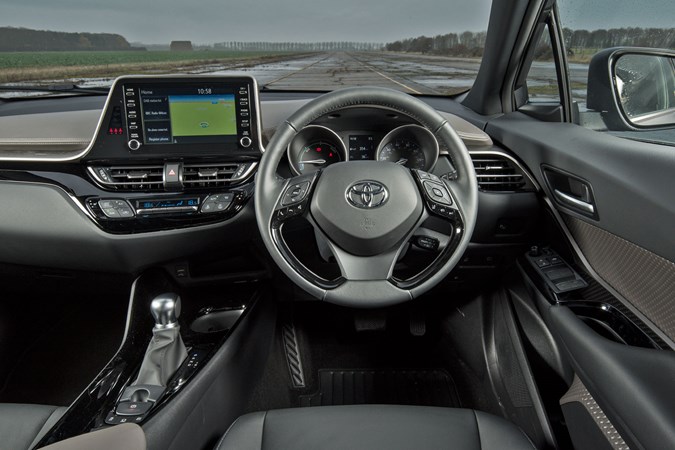
What I’d really like, though, is for Toyota to take the infotainment display from its facelifted C-HR and plop it into the UX. I’ll speak a bit more about the relationship these cars share and which comes out on top in my final update, but in terms of tech the Toyota is leagues ahead thanks to its provision of both a touchscreen and Apple Carplay/Android Auto connectivity.
Fuel economy: 45.0mpg
Update 6: Farewell
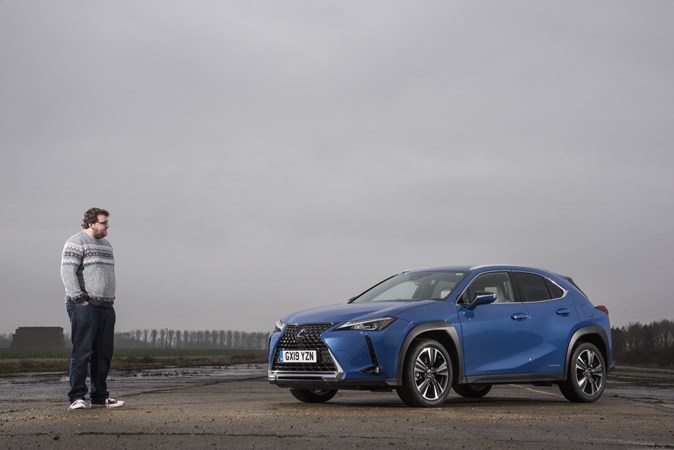
After six months and a few thousand miles in the Lexus UX, it’s time to wave goodbye – and collect my thoughts on the time I’ve spent with this premium, hybrid SUV. This obviously wasn’t the typical long-term loan, as it was punctuated in the middle by a nationwide lockdown period. But I handed the car back with plenty of opinions – mixed ones – which I’ll attempt to share now.
Overall? I really like the UX. It’s not quite my favourite of the Lexus lineup – that honour goes to the LC, followed by the RX, because deep down I’m a fancy gal trapped in the body of a cash-strapped journalist. Yet even the UX’s status as the baby of the range doesn’t make it feel in any way budget. Little touches, like the soft-close electric windows, the sumptuously supple leather, the intricate analogue clock on the dash – none of them are what you’d call essential, but they elevate the UX above a similarly-sized offering like the Volkswagen T-Cross.
Looks don’t fade
Divisive – yes. But the UX still looks fresh and I think it’s a particularly smart addition to this market sector.
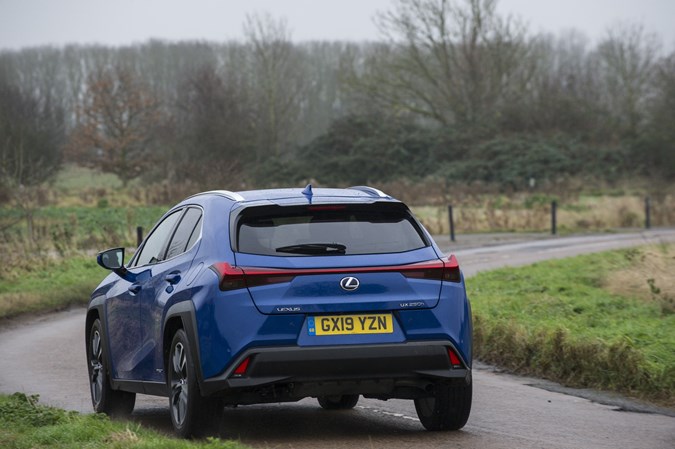
At night, things only get better. I love the lighting signatures on this car – they’re unmistakably Lexus, yet different to the rest of the range. Full-width taillight elements are becoming more commonplace, but the UX has a particularly clean example. You’ll definitely know if you’re following one of these home.
Great to drive – with caveats
I don’t think the self-charging hybrid system is for everybody. Mechanically involving it is not – even less so than a conventional automatic, so if you like to feel as though you’re innately connected to your car, a Lexus hybrid is not for you. Try a Porsche Macan, or something with a manual gearbox.
But it didn’t take long for me to get used to how the UX proceeds along the road. The electric motor, continuously variable transmission and engine have a pretty harmonious relationship; certainly, some time spent in other manufacturer’s hybrid models has given me new appreciation for how Lexus has tuned its self-charging hybrid system.
It shouldn’t be surprising, really, as parent brand Toyota has been building hybrid cars for more than two decades now…
Practicality still a problem
Truly, the size of the boot was my biggest issue with the UX. I’ve already had a long moan about it above, so I won’t go into it too much here, but I reiterate – any car, even the sportiest of roadsters, ought to be able to cope with a midweek shop for two people. A compact SUV? Well, the bar’s set even higher.
Having normal-sized shopping bags distending the flexible parcel shelf and spoiling rear visibility is something that never stopped grating on me, especially during lockdown when a trip to the supermarket was the only time I drove the car at all.
How much did it cost to run?
Here’s another area the UX left me disappointed – its fuel consumption. I’ve spent plenty of time in Toyota hybrids before now, and I’ve always been incredibly impressed at their economy. A long weekend in a Toyota Corolla 1.8 Hybrid once saw me average over 65mpg with ease – the beauty being that, unlike a diesel, that economy figure is possible even on short journeys.
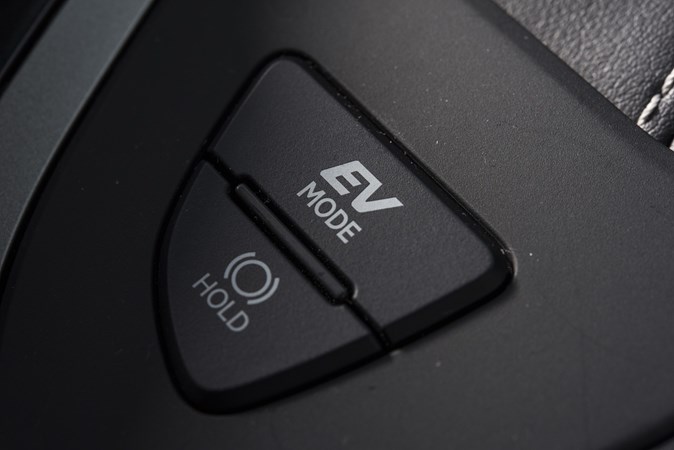
Yet in the UX I’ve never exceeded the 47.9mpg I got during my first month with the car, and over my months it’s averaged out to just 45.5mpg. With official WLTP figures for my two-wheel drive model being a claimed minimum of 49.5mpg, I’m a little disappointed – and I’m certainly no lead-footed speed freak. During its worst month, where a slightly quicker colleague borrowed it, the UX returned just 43.5mpg.
But overall, how does the UX stack up to a closely-related model? Well, that’s where things get awkward, because you see…
I’d rather have a Toyota C-HR
At launch the Toyota C-HR was only available with a rather asthmatic 1.8-litre self-charging hybrid powertrain, so it took until the facelift and the introduction of a 2.0-litre alternative to become a rival to the UX.
After sampling the two back-to-back I have to admit the C-HR is a better car. Though its powertrain is very closely related to the system in the UX, the difference in response is remarkable. The C-HR has a genuine degree more immediacy when you pull away – its handling is keener and its steering rack quicker, too.
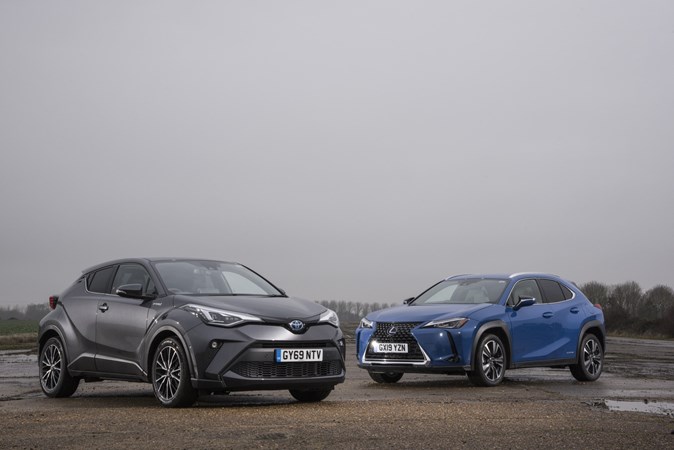
You don’t lose much in comfort, either, and the C-HR’s boot is enormous compared with the UX.
The C-HR doesn’t have anything like the interior ambiance that the UX enjoys, but it’s still neatly designed and laid out and – joy of joys – it has Apple CarPlay and Android Auto built in. That’s something new UX’s do get, but the update to install it to my car wasn’t ready before I had to hand it back.
Final thoughts
The UX is good-looking, has a cracking interior, is superbly comfortable on a long journey and is even reasonably good value considering the kit that’s on offer – once you choose a few carefully considered options packs, that is.
Is it worthy of converting buyers of premium German SUVs, such as the Audi Q3, BMW X1 or Mercedes-Benz GLA? I think it is, but whether those drivers would even consider a Japanese car with the quirks of the UX over its Teutonic competition is perhaps unlikely.
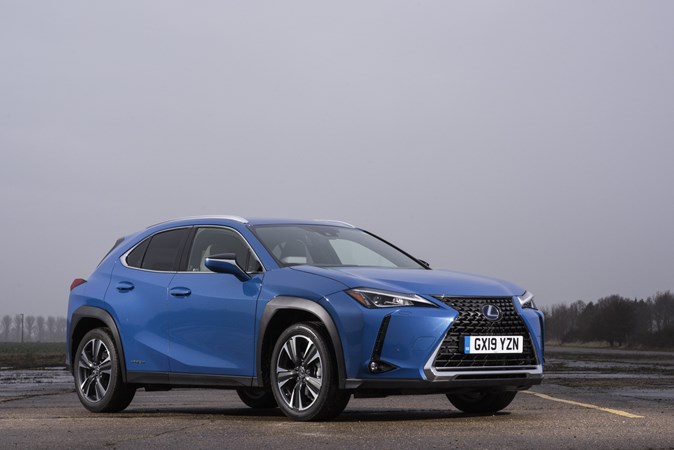
I still recommend taking one for a test-drive, though. You never know, you may be drawn in to the world of Lexus – a place where dependability and customer service rule the roost. It’s this, rather than the car itself, that would tempt me into Lexus ownership.
Fuel economy: 45.4mpg
Total average: 45.5mpg



